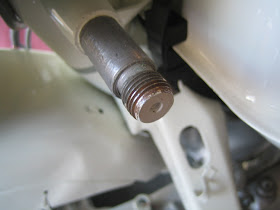Make sure that the lug for mounting the rear shock at the top of the frame is clean and smooth. Ours still has tape applied which was used to protect it and the threards whilst it was being painted. Scrape this away and then use grit paper to finigh before cleaning.
Use a little grease on both the fraem lug and engine lug to ensure the shocker rotates properly when in use. Normal Grease is usually fine but I am using copper grease, which in my opinion, for applications like this, is far better and lasts a great deal longer than ordinary grease.
Get help to lift the frame so that the uncompressed shocker can be slipped over the lugs. Notice which way up the shock absorber is fitted. I can't count the times I've seen them fitted upside down.
The nuts required to tighten the shocker are spcifically for the job and two wavy washers are also required.
There is no torque setting for these nuts but they do need to be nice and tight without the need for using extra leverage or hitting them with a drift hammer to get extra grip.
Once installed, make sure you check behind the shocker to ensure it is NOT rubbing against the rear mudguard. Mudguards can go a little mis-shapen when blasted or painted and can bow a little when being installed. This will cause it to catch on the shocker and that is something you don't want on your shiny new parts.
If it does, you should be able to bend it in a little by hand. until there is sufficient clearance.
Job done!






Great help, thanks... This helped me fit a new shock to my series 2 Lambretta.
ReplyDelete